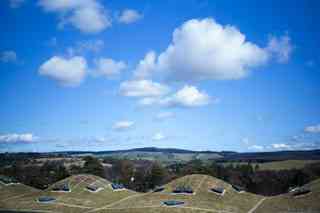At the distilleries in the Scottish Highlands, tradition reigns supreme: Centuries-old estates house outfits that specialize in crafting spirits with technique passed down through generations—even the product itself is often aged for decades. This week, one such outfit has unveiled a strikingly contemporary structure, whose dramatic, undulating form echoes the Scottish landscape and marries old-world craftsmanship with state-of-the-art engineering. In a process that began over six years ago with an international competition, the Macallan tapped London-based Rogers Stirk Harbour + Partners for the region's most state-of-the-art facility, a nearly 50,000-square-foot distillery and visitor experience center whose graceful form belies its technical complexity. When approached from the estate's long drive, the building appears as a slash cut out of the countryside, a visual representation of the Macallan's connection to its surroundings.

Much like the tradition of whiskeymaking itself, the structure, for all its contemporary marvel, has its roots in Scottish heritage, which is, in many ways, inextricable from its landscape. "We decided to make it part of the land, but we needed it to be an artificial part," says Graham Stirk, senior partner at RSHP. "So we looked to Scottish cairns, which are essentially man-made, serpentine forms, to make something sinuous."

For all its graceful exterior curvature, though, the roof (shown here during construction) is actually a complex network of more than 380,000 components arranged in a geodesic shape. Stirk and his team developed a boxlike, three-dimensional LDF beam that allowed for a curved vaulting system without the use of any bent wood. "To do it in straight beams would mean the bottom of the beams would be flat, and if you have a beam with a flat bottom, it looks a little bit like things colliding," the architect explains. "So we did two sheets of ply with a box on each side and we varied the bottom edges, so that they follow the curvature."

Though the exteriors of the domes are planted with grass, inside, the plywood is left uncovered. "We wanted the warmth of the timber to balance the industrial nature of the equipment," Stirk says. This view into the building process echoes a similar attitude in the distillery, where copper stills (which were created as exact replicas of the company's first ones, by the same coppersmithery, five miles down the road) are visible through floor-to-ceiling glass windows on the bar level. As the Macallan's creative director Ken Grier explains, "We wanted it to be transparent—we wanted to share our secrets." The stills are arranged into several circular groupings, another nod to a part of Scottish heritage: the broch, an ancient, circular tower.
The domed ceiling is further supported by several steel beams, which "mark the points between what is going up into a vault and what is hanging," Stirk explains.
"It's a man-made structure based on ancient Scottish earthenworks which sits nestled within the Scottish landscape," says Grier by way of explaining the building's connection to its heritage. The five-year project cost $188 million and employed 400 workers, many of them local and many specializing in a craft passed down through generations.
To Stirk, the structure was an opportunity to do something he'd long wanted to. "We always said we'd love to make the most beautiful distillery on earth," the architect says. His work on Lloyds of London had inspired a longtime obsession with designing pipe systems that integrate into interior architecture. "We thought, Let's just make it the most beautiful coordinated distillery. Rather than just do an architectural building and then have someone come in and put their stuff inside, we thought we would try to make the two talk to each other."
The structure's undulating "hills" owe their form to Stirk's precise engineering. "We had to generate whole rings of identical pieces, so we had to create a lot of repetition," the architect explains. "It's about economy; it's a system, that can be replicated. It's a mathematical, systematic structure."
As for the team at the Macallan, they hope the singularity of a contemporary structure cut out of a largely wild landscape will underscore their own forward-thinkingness. "Anyone can open a bottle shop," Grier muses. "When you do stuff that's different, new, contemporary, you make the brand relevant and you connect in an interesting way. You have to keep evolving."
